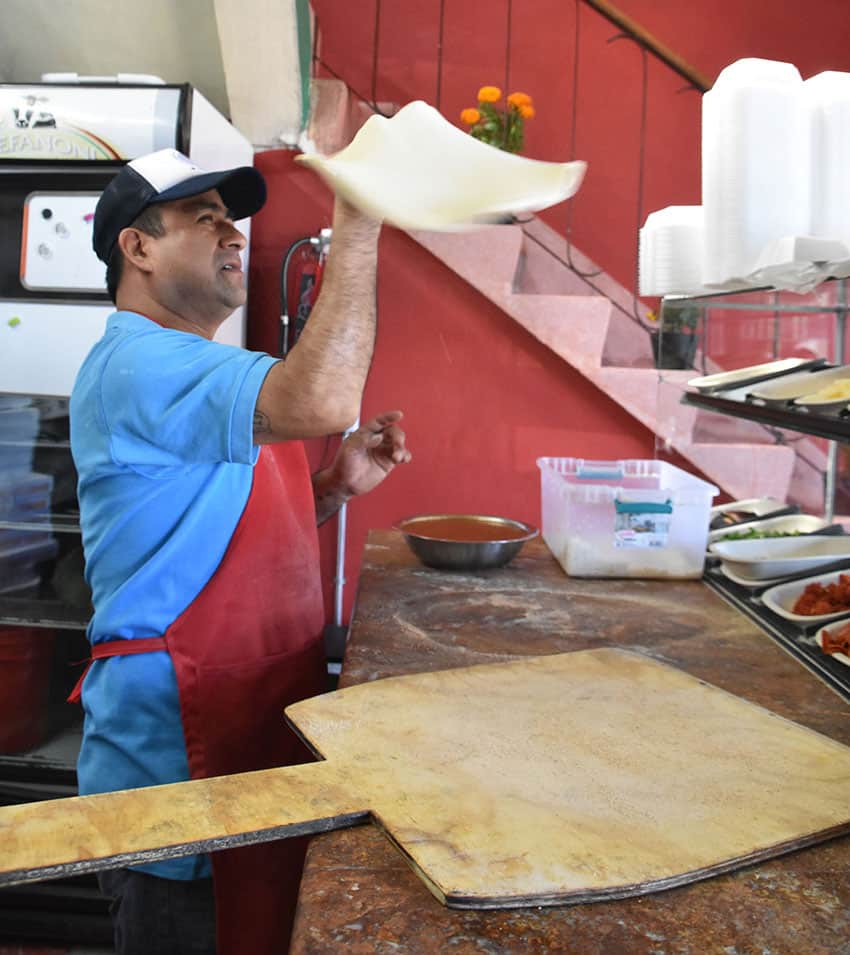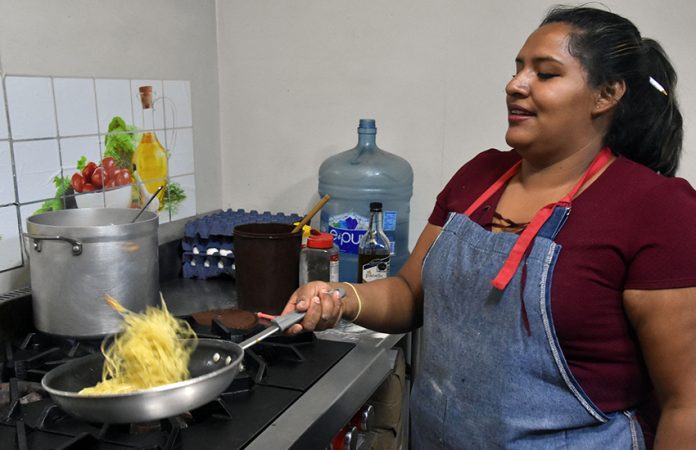When 38 families from the Veneto region in northern Italy arrived in Mexico in October 1882, eventually settling in Chipilo, Puebla, they brought with them their language, traditions and, of course, their recipes.
While chipileños, as they’re called, have held tightly to their language and traditions, many of their recipes have changed, incorporating foods and spices found in Mexico. In some cases, chefs have invented completely new dishes that mix the two cuisines.
Leonardo Stefanoni Mazzocco studied at Maria Reyna Gastronomía, a culinary school in Puebla, and opened Restaurante El ItaloMexicano in May 2002 on the highway that skirts Chipilo.
“Mexican and Italian foods mix well together,” he said.
Although spicy foods are well accepted in Chipilo, he’s had to make some changes.

“We use garlic, but less because Mexicans aren’t accustomed to it.”
There are a lot of options on his menu that show his ability to meld the two cuisines. There’s a dish called Conejo Chipileño (Chipileño Rabbit) that has jalapeños, a variety of herbs and, he said, “an excess of pepper, which is an Italian touch. It mixes well with the chiles.”
As expected of an Italian restaurant, there are plenty of pasta dishes on the menu. And while some are solely Italian in flavor, there are a number that combine the two cuisines. For example, there’s fettuccini with mole poblano and a pasta enojada, which is penne pasta in a tomato sauce that’s made with chiles, giving it a serious kick.
An interesting option is Plato ItaloMexicano: a generous plate of three pastas that honors the Mexican and Italian flags with their identical colors: penne with salsa enojada (red); gnocchi in a cream sauce (white) and spaghetti with pesto (green).
His salads are a mix of Italian lettuces — like radicchio and arugula — and Mexican ones like romaine. “It is a mix of the sweet with the bitter,” he said, “so that the salad is not so strong.”
There’s also a salad made from darichi (dandelion) that’s popular in northern Italy. “We modify it by adding bacon,” Mazzocco explained, “because Mexicans aren’t used to it.”

Stefanoni’s is not the only restaurant featuring a melding of the two countries’ cuisines. Chipilo’s main street is lined with restaurants that showcase their own take on Italian-Mexican cooking.
There’s Il Canton de Italiano, owned by Paolo Solimón, who moved to Chipilo from Vicenza, Italy, in 2002. He missed Italian food, so although he had no formal training, he opened the restaurant in 2008.
“I learned how to cook from my grandparents, from my nonna,” he said. “They are the best to learn from.”
His Pizza Mexicano is a local twist on the traditional, featuring jalapeño, beans, avocado and crema, akin to sour cream. Solimón suggested Pasta Ajo as the best example of a pasta that mixes Mexican and Italian flavors. It’s a pasta dish that Dulce María Tecuapetla, who’s been the restaurant’s cook for 10 years, makes by frying up a generous helping of garlic and red chile. Eat a plate of that and you won’t worry about vampires for a few days.
Although he uses Mexican herbs in many of his dishes, Solimón draws the line at cilantro and epazote. “They do not mix well with Italian food,” he said.
Just up the street from Solimón’s restaurant is Bella Pizza, which has been managed by Salvador Gutiérrez for 10 years. He learned how to make pizza in Los Angeles and brought his skills to Chipilo, where he makes a pizza that has satisfied my desire for a real New York-style slice: thin crust, lots of cheese and a delicate layer of oil floating on top of it all.

He starts his pizza by first stretching the dough on the counter and then tossing it in the air several times. “I do this for two reasons,” he explained. “First, it is an exhibition. Children really like it. Second, the dough is hard to stretch, and tossing it makes it easier.”
“It’s traditional pizza made in a wood oven,” he said. “We always use wood because it gives the pizza a better flavor; it cooks more consistently. We make it with local cheeses — all Chipileño cheeses — and Italian sauce. But we add jalapeños … habaneros, squash and chorizo, so now it’s a Mexican pizza.”
He doesn’t use avocados, which are a staple on many traditional Mexican pizzas, saying that they can turn black. Like Solimón, he avoids cilantro and epazote. On Tuesdays and Thursdays, the pizza’s twice as good because, amazingly, it’s two pizzas for the price of one.
A favorite stop for breakfast is Buon Giorno, owned and operated by Karina Stefanoni for eight years. “The recipes are from my family,” she said. “My influences are my mother and grandmother, who came from Italy.”
Surprisingly, despite their influence, she doesn’t use basil in any of her dishes, simply saying, “It does not go well.” But, unlike Gutiérrez and Solimón, she does use cilantro and epazote, especially in her salsas, which she said are spicy. “The food is picante, which Italians normally do not use,” she continued.
Her Huevos a la Italiana mixes Italian prosciutto and arugula with Mexican salsa and crema. It all sits atop a slice of bread. “The bread is a recipe from my grandmother and great-grandmother,” she said.

The menu is also filled with traditional Mexican offerings. “Chilaquiles are one of the specialties asked for a lot,” she said.
Her chilaquiles are baked (or stale) tortilla strips smothered with salsa and crema and topped with avocado. “We have used the same recipe for eight years, one from my mother, who learned it from her mother, who is Italian.”
The salsa is a little milder than typically found in Mexican restaurants, probably due to her grandmother’s influence.
One particularly interesting item is Huarache Nopalero. It’s a nopal pad on top of refried beans and covered with salsa, panela cheese and crema. “It is a recipe my nonna used,” Stefanoni said. “They started making it when they came to Chipilo.”
Chipilo has many restaurants and pizzerias to choose from. Most are located along its main street, but there also are several on the highway that runs alongside the pueblo. The small restaurants, called fondas, are strictly Mexican, but the larger ones are all Italian Mexican.
Some are more Mexican, others more Italian. Trying them all to find the one with the right balance for your own palate is part of the fun.
Joseph Sorrentino, a writer, photographer and author of the book San Gregorio Atlapulco: Cosmvisiones and of Stinky Island Tales: Some Stories from an Italian-American Childhood, is a regular contributor to Mexico News Daily. More examples of his photographs and links to other articles may be found at www.sorrentinophotography.com He currently lives in Chipilo, Puebla.
